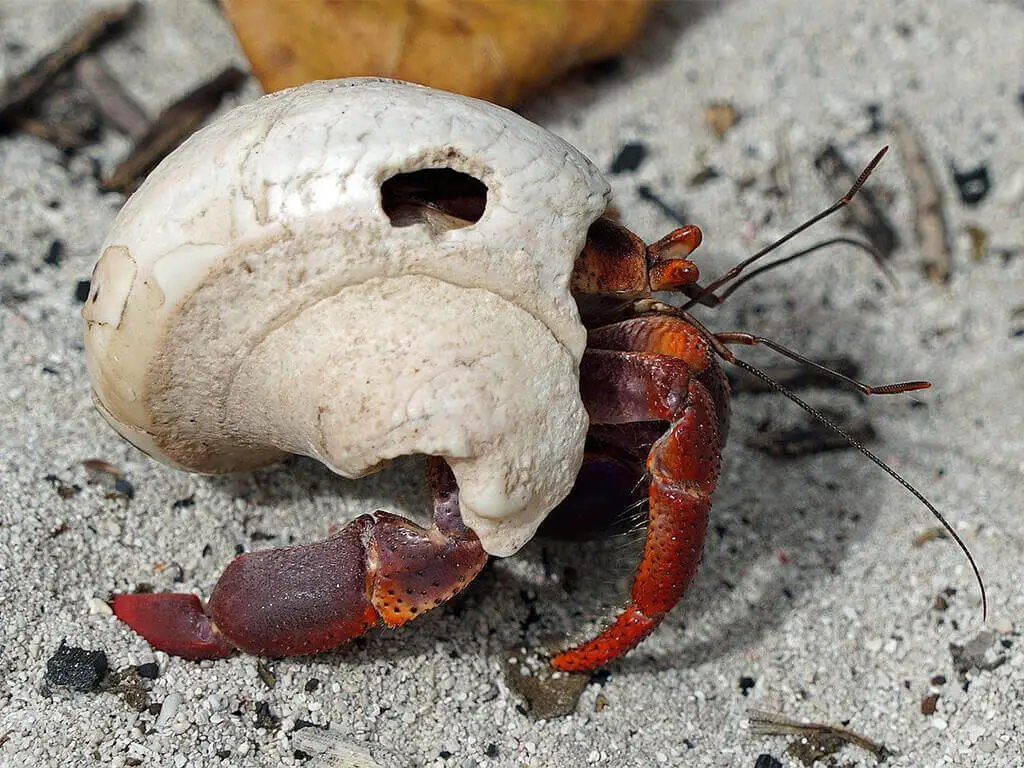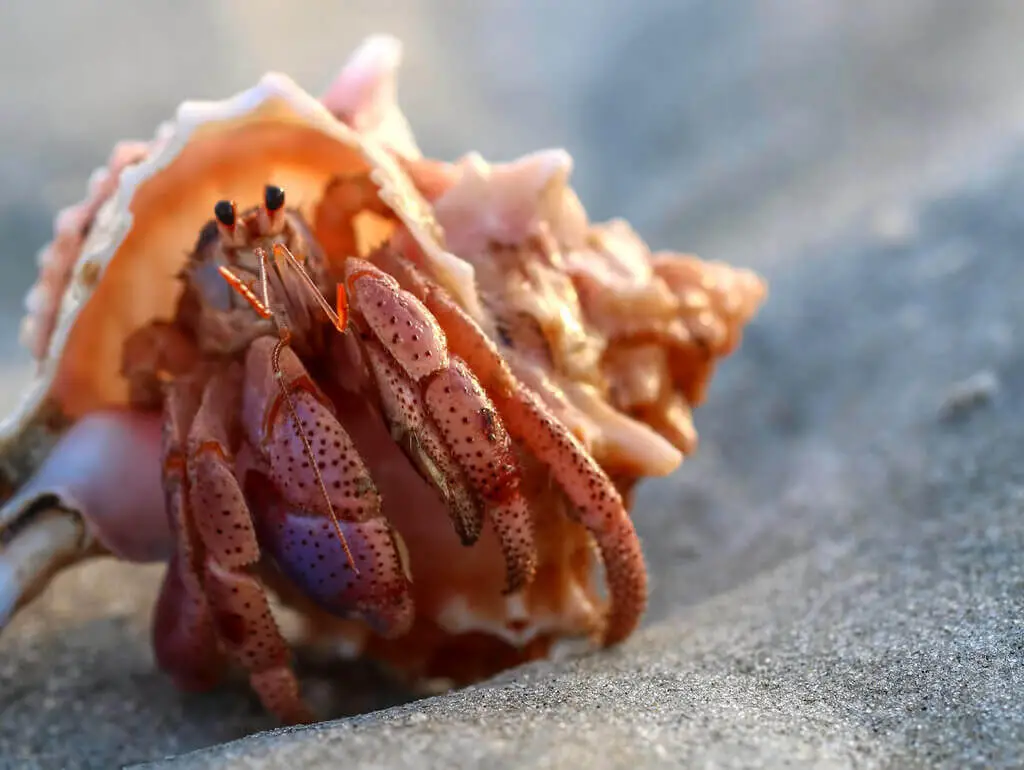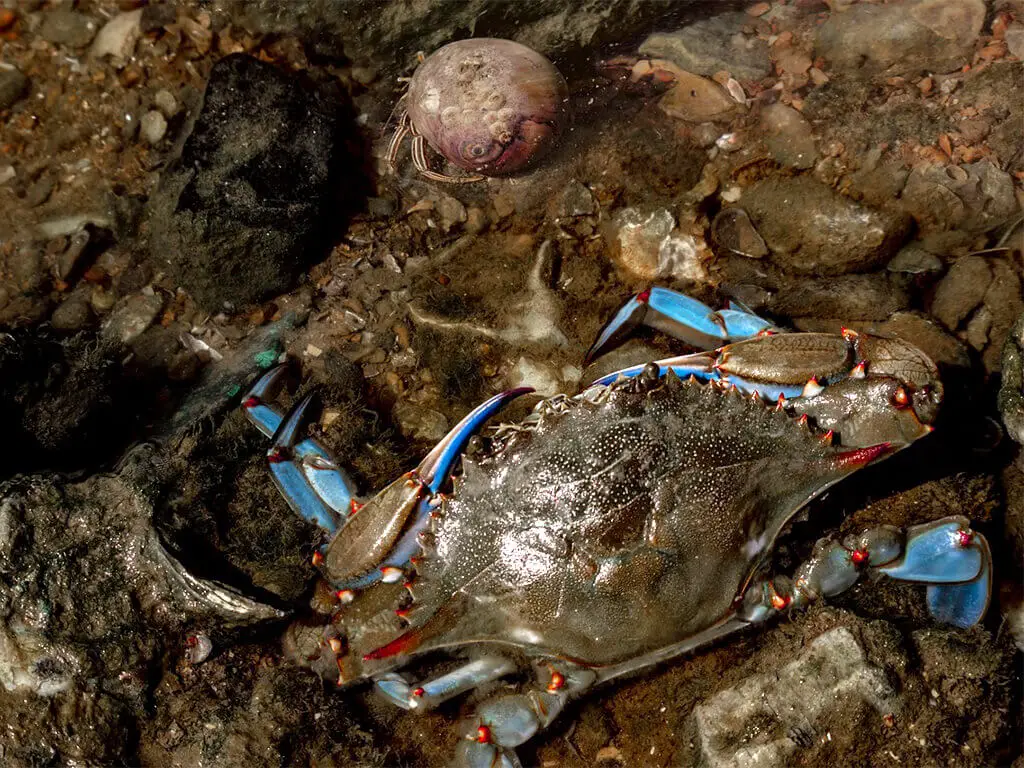Hermit crabs belong to an omnivorous scavenger family. It means they can eat anything they capture.
These crustaceans are native to the ocean’s deep and shallow water and can consume macroalgae, mussels, shellfish, and fragments of deceased animals.
For this reason, people often keep these sea creatures as pets rather than eat them. However, can you eat hermit crabs?
This post will show you the reasons and everything about this crustacean species. Let’s dive into it to explore!
What Are Hermit Crabs?
Hermit crabs are invertebrates consisting of two primary categories: sea dwellers and land dwellers, with more than 800 species worldwide.
The shallow and deep regions of freshwater or saltwater are home to marine hermit crabs. On the other hand, land dwellers can stay on both water and land. You often see them on the sand in shallow water bodies.
These omnivorous crabs hunt for food through scavenging, frequently consuming tiny clams, mussels, algae, and bits of animal carcasses. When provoked or in danger, they withdraw inside their shell and stay there until they feel safe.
They only feature an exoskeleton on their fronts, unlike what you may commonly imagine when you picture a regular crab. However, when it comes to the body parts, these creatures also feature ten jointed legs, making them look like other crabs.
Although hermit crabs reside alone within abandoned shells, they like to dwell in big groups in nature. When they “molt” or replace their shells, they look for a larger one and offer their old ones to other relatives.
These creatures are available in various sizes and shapes. They can live up to at least 30 years in favorable conditions.
Hermit crabs are sometimes used as bait in fishing, and people love them as pets too.


Can You Eat Hermit Crabs?
Eating hermit crabs is acceptable because they aren’t poisonous. However, they are not ideal meals due to their distasteful meat and risk factors.
These crustaceans are scavengers and omnivores, so they can consume anything they catch, including dead animals and even plastic pollutants, and then they will carry toxins inside their bodies.
If you prefer to try these hermit crabs, it’s best to look for the crabs that live in areas that have been proven to be unaffected by environmental pollution.
Moreover, these crustaceans are not tasty and have little meat of not-so-excellent quality. They won’t taste like other crustacean species you often eat, such as King crabs or Dungeness crabs.
Hermit crabs are only edible in specific circumstances, but they are more challenging to prepare and consume because you’ll have to crack shells to pull this small crustacean out. Therefore, most chefs in famous restaurants don’t use them in their recipes.
What Do Hermit Crabs Taste Like?
They taste like shrimp despite being classified as crabs because of their almost identical diet.
Compared to other crabs, they are rather salty and boast a more pungent seafood taste.
If you want to prepare these crabs, you’ll need to add other ingredients and seasonings to enhance the flavor.
Moreover, these creatures have relatively little meat, so adding veggies also helps the meal to be more filling.
What Is the Nutritional Value of Hermit Crabs?
While these crabs belong to the crustacean family and have some nutrients, they are unhealthy because of their diet.
Hermit crabs provide intermediate nutrition compared to other types if maintained with a specific feeding diet.
Are Hermit Crabs Safe to Eat Raw?
Eating these crustaceans raw is a bad idea. They have parasites and poisons that are harmful to your health.


How to Clean and Cook Hermits
It would be best never to eat dead hermit crabs since they will begin to decay and turn poisonous. Preparation and cooking are the same as those of other crabs.
Preparing hermit crabs requires much time and effort, so follow these easy instructions.
Preparations
- To keep hermit crabs from escaping, put them in a bowl-shaped strainer. Remember to cover it.
- Wash the colander under running cold water. Ensure the crabs are clean and dirt-free.
- Break the shell to pull the hermit crabs out. Otherwise, boil them and take them out.
- Wash the crabs again under running water after pulling them out.
Read more: How to keep crabs alive until cooking
Step-by-Step Instructions
As shared earlier, the taste and the flavor of hermit crabs are relatively unsavory, so it’s best to combine them with other ingredients.
If you don’t know what to cook with these crabs, let’s refer to the following hermit crab recipe:
Step 1: Prepare these ingredients:
- Hermit crabs: 1 kilogram
- Corn: 2 pieces
- Potatoes: 5 pieces
- Lemon: 1 piece
- Water: 2 cups
- Vegetable oil: 3 tbsp
- Butter: 1 stick
- Cajun seasoning: ¼ cup
- Minced garlic: 1 head
- Salt: ½ tbsp
- Brown sugar: 1 tbsp
- Peanut butter (optional)
Step 2: Set the stove to medium heat and place a pan on it.
Step 3: Add water and salt to the pan. Bring it to a boil.
Step 4: Put butter and vegetable oil in another pan. Add garlic and saute it until it turns golden brown.
Step 5: Add hermit crabs to the pan. Stir well for around one minute. Keep cooking for three minutes.
Step 6: Pour sugar, salt, and Cajun seasoning into the pan.
Step 7: Add the vegetables. Continue cooking for 5 minutes.
Step 8: If you want a creamier sauce, it’s a good idea to use peanut butter.
Step 9: Serve hot. Enjoy your dish!
If you want more recipes to cook these crabs, you can watch this video:
What Makes Hermit Crabs Different from Other Crabs?
Hermit crabs are the lightest crustaceans because their bodies are thinner and softer than other crabs.
Since they lack a hard shell and don’t have harsh bodies, they are susceptible to the surroundings and are, therefore, more vulnerable.
They also have a dirtier lifestyle. They become filthy than other crustaceans because they are more domesticated and do not travel around much.
One of the leading causes for people to reject them is the filth and stench of the shells. Additionally, their waste accumulation forces more spilled water, while rotten food seems to cause their bodies’ unpleasant stench.
If you are interested in morphology, you may realize that hermit crabs are not close relatives of other crabs.
More clearly, these creatures belong to the decapod crustacean genus of the Paguroidea superfamily.


FAQs
Is Hermit Crab Tasty?
The short answer is no! These creatures are omnivorous scavengers, so they eat anything they see, including dead animal carcasses.
Their meat is distasteful when you cook it alone. For this reason, you must combine it with other ingredients and seasonings if you want to try it.
Are Hermit Crabs Poisonous to Human Beings?
The good news is no! They are not poisonous to humans.
However, it’s a different story if you eat them raw. Because these crustaceans consume dead animal carcasses and plastic pollutants, they may contain toxins.
If you cook them poorly or eat them raw, you can get food poisoning.
Are Large Hermit Crabs Edible?
You can eat hermit crabs of all sizes, but tiny ones have little meat. For this reason, large crabs are always the best choice.
You should select types at least four inches wide to have enough meat.
What Hermit Crabs Are Toxic?
The hermit crab itself is not toxic. If you get store-bought types, they may contain a preservative called Ethoxyquin. It’s the primary ingredient making your dish poisonous.
How Do You Know If It’s a Healthy Hermit?
Check their legs and other body parts outside. If you come across a Hermit with red claws and legs, it’s a healthy crab.
On the other hand, if it has a darker color or gray hue, it may experience many challenges in the natural environment.
Do Hermit Crabs Carry Parasites?
The answer is yes. Land hermit crabs may carry mites that adhere to their gills. Their shells can also contain polychaete worms.
In a Nutshell
Can you eat hermit crabs? Although these crustaceans are edible, you should not consume them due to their little and unsavory meat and risk potential.
If you still want to try these creatures, it’s best to cook them with other ingredients and seasonings to enhance the flavor.
Most importantly, remember to clean and prepare them properly. Never eat them raw due to toxic substances.
If you have further questions, please comment below. We will answer them all. Thanks for taking the time to follow this post!
















I view something genuinely interesting about your website so I saved to fav.
My brother recommended I might like this web site He was totally right This post actually made my day You cannt imagine just how much time I had spent for this information Thanks
Your point of view caught my eye and was very interesting. Thanks. I have a question for you.
Can you be more specific about the content of your article? After reading it, I still have some doubts. Hope you can help me.